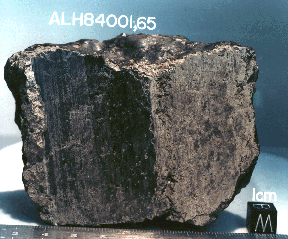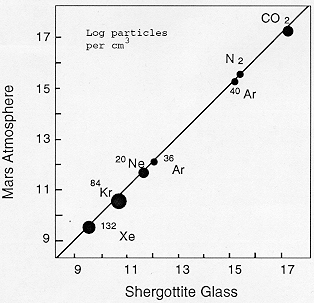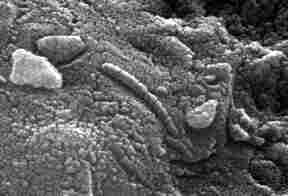Meteorites from Mars
 While we've landed machines on Mars
and sampled the soil, no mission has returned with rocks from
Mars. Luckily, nature has brought a few
to us! This has given us crucial information. To the right
is the famous Martian Meteorite, ALH84001 (more below).
While we've landed machines on Mars
and sampled the soil, no mission has returned with rocks from
Mars. Luckily, nature has brought a few
to us! This has given us crucial information. To the right
is the famous Martian Meteorite, ALH84001 (more below).
About 50 meteorites have been identified as coming from Mars. How do they (scientists) know that?
1) They are very young igneous rocks, < 1.3 b.y.o. Asteroid/Comet meteorites formed when the Solar System formed (4.5 b.y.o.).
 2) Since they represent recent formation, they must have
come from a planet which could support volcanism in the
last billion years. Only Venus, Earth, and
Mars are big enough to still have internal Heat.
2) Since they represent recent formation, they must have
come from a planet which could support volcanism in the
last billion years. Only Venus, Earth, and
Mars are big enough to still have internal Heat.
Why MARS? Gases trapped in a few of these meteorites show the exact same unique isotopic ratios as found in Mars' atmosphere by Viking mission --->
These meteorites are sometimes called SNC (pronounced, `snick') for the first three of these types found (Shergotty, Nahla and Chassigny, found > 100 years ago).
How did rocks from Mars get here? Impacts drove them off with great velocity from the Mars surface (need 5.4 km/s to escape Mars' surface).
What have they told us?
A few show water in them. Others
show crystals or clay sediments, from interaction
with water. Comparing the ages of the rocks with the gases
contained, it tells us about the development of Mars' atmosphere,
and how it lost its light elements quickly, a different evolution
than occurred on Earth.

ALH 84001 and possible evidence for Martian life
Perhaps the most striking evidence for past life on Mars is the
following picture. The nanoscale 'bacteria-like' structures were found to lie
deep within internal cracks and fissures of ALH 84001. The meteorite also shows
evidence of water erosion and carbonate deposits, indicating the
rock existed for a time in liquid water.